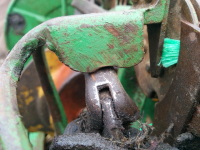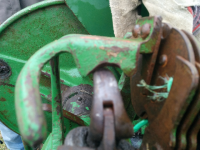coondle
Bronze Member
First thing to do is replace the wire wound on the wiper arm shaft with washers, really shims ie different thickness washer/s to give a firm fit without end play but not so tight as to impede the rotation of the wiper arm. The billhooks are usually really shiny, although I assume they have been cleaned up. If a smoother finish is needed use wet and dry paper of at least 400 grit and instead of dry or with water use a small quantity of lubricating oil on the carborundum paper, it may also be known as emery cloth. The oil helps give a very smooth finish.
The wiper should make a reasonably wide contact with the billhook. The video shows only a small contact not central to the centre line of travel on the billhook. The video shows contact to the left of centre.
Although filing is a last resort, I think that the wiper of the knife arm should be very gently filed to give a rounded profile to match the curved profile of thebillhook that the wiper traverses. The knife arm should be bent to give good contact of the wiper to the billhook and the wiper should not have any taper in the direction of travel such that twine would wedge under its leading edge.
You have asked the question in regard to knife clearance from the twine disc holders. The knife arm when fitted with the shims should not foul on the twine holder discs but does not have to be in very close proximity. The knife itself should be sharp and can be touched up with an oilstone to make it almost razor sharp.
In the passage of the knife arm toward the billhook to wipe the formed knot from the billhook, the knife passes the tightly tensioned strings and cut them only a moment before the wiper removes the formed knot from the billhook and can do so because the twine ends have just been cut leaving a small residue length of twine, about 1 inch long which falls out of the twine disc holder and the other end is already held in the next station of the twine disc which rotates ready for the next bale to be formed. That end which was held and cut off from the looped and just formed knot is the little bit of cut twine that appears on the top of the bale chute behind the knotters.
I like zzby6's use of two crescent spanners to achieve adjustment of the wiper arm. Much more controlled than my hit with a hammer.
After a few failed knots build up on the billhook, the knots pull very very tight on the billhook and are almost impossible to remove so the wiper has to jump over the growing bundle of knots and is bent away from the billhook just as zzby 6 says.
To get the build op of knots off the billhook, undo the knotter from its secured position and swing the knotter up as is shown in the video and flick the billhook tensioning arm off the billhook roller, this allows the billhook beak to open and gives you room to cut the sides of the knot tangle from the billhook with a sharp knife. Do not use something like a hacksaw blade because the teeth can damage the smooth surface of the billhook. Replace the billhook tensioning arm snugly over the billhook roller. Fold the knotter assembly back down and secure it in position.
Good luck with the fix, and happy baling.
The wiper should make a reasonably wide contact with the billhook. The video shows only a small contact not central to the centre line of travel on the billhook. The video shows contact to the left of centre.
Although filing is a last resort, I think that the wiper of the knife arm should be very gently filed to give a rounded profile to match the curved profile of thebillhook that the wiper traverses. The knife arm should be bent to give good contact of the wiper to the billhook and the wiper should not have any taper in the direction of travel such that twine would wedge under its leading edge.
You have asked the question in regard to knife clearance from the twine disc holders. The knife arm when fitted with the shims should not foul on the twine holder discs but does not have to be in very close proximity. The knife itself should be sharp and can be touched up with an oilstone to make it almost razor sharp.
In the passage of the knife arm toward the billhook to wipe the formed knot from the billhook, the knife passes the tightly tensioned strings and cut them only a moment before the wiper removes the formed knot from the billhook and can do so because the twine ends have just been cut leaving a small residue length of twine, about 1 inch long which falls out of the twine disc holder and the other end is already held in the next station of the twine disc which rotates ready for the next bale to be formed. That end which was held and cut off from the looped and just formed knot is the little bit of cut twine that appears on the top of the bale chute behind the knotters.
I like zzby6's use of two crescent spanners to achieve adjustment of the wiper arm. Much more controlled than my hit with a hammer.
After a few failed knots build up on the billhook, the knots pull very very tight on the billhook and are almost impossible to remove so the wiper has to jump over the growing bundle of knots and is bent away from the billhook just as zzby 6 says.
To get the build op of knots off the billhook, undo the knotter from its secured position and swing the knotter up as is shown in the video and flick the billhook tensioning arm off the billhook roller, this allows the billhook beak to open and gives you room to cut the sides of the knot tangle from the billhook with a sharp knife. Do not use something like a hacksaw blade because the teeth can damage the smooth surface of the billhook. Replace the billhook tensioning arm snugly over the billhook roller. Fold the knotter assembly back down and secure it in position.
Good luck with the fix, and happy baling.

